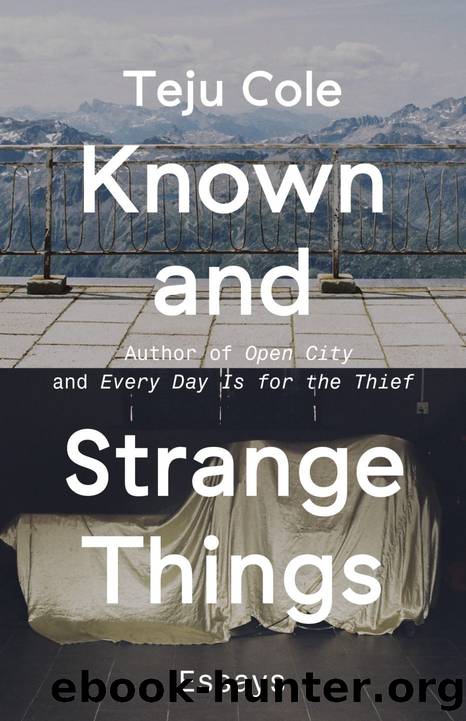Known and Strange Things: Essays by Cole Teju

Author:Cole, Teju [Cole, Teju]
Language: eng
Format: epub
Tags: Art, History, Politics, Travel
Goodreads: 25743316
Publisher: Random House
Published: 2016-08-09T07:00:00+00:00
Death in the Browser Tab
THERE YOU ARE watching another death on video. In the course of ordinary lifeâat lunch or in bed, in a car or in the parkâyou are suddenly plunged into someone elseâs crisis, someone elseâs horror. It arrives absurdly, in the midst of banal things. That is how, late one afternoon in April, I watched Walter Scott die. The footage of his death, taken by a passerby, had just been published online on the front page of The New York Times. I watched it, sitting at my desk in Brooklyn, and was stunned by it.
A video introduces new elements into the event it records. It can turn a private grief into a public spectacle, and set popular opinion at odds with expert analysis. Within the space of a year, I saw too many such videos. I watched the fatal shooting of twelve-year-old Tamir Rice, who was holding a toy gun in a Cleveland park. I watched a police officer choke a protesting Eric Garner to death. I watched Charly Leundeu Keunang tussle with police officers on a sidewalk in Los Angeles before one of them unloaded six bullets into him. And there was much I could have watched but opted not to: the ISIS beheading videos, the various other clips of deadly violence from around the world. Even so, just from the grim catalogue of what Iâd seen, I felt that death had come within too-easy reach, as easy as opening up a browser and pressing play. I recognized the political importance of the videos I had seen, but it had also felt like an intrusion when I watched them: intruding on the sorrow of those for whom those deaths were much more significant, but intruding, too, on my own personal but unarticulated sense of right and wrong.
For most of human history, to see someone die, you had to be there. Depictions, if there were any, came later, at a certain remove of time and space. The day after I watched the video of Walter Scottâs death, it so happened that I taught my students at Bard about a series of woodcuts by Hans Holbein the Younger. Holbeinâs woodcuts, designed around 1526 and entitled Pictures of Death, showed Death in the form of a skeleton arriving for each of his victims: a nun at prayer, a farmer plowing his field, a pope on his throne, a knight in full armor. Considering these prints made me understand something about videos like those of Walter Scottâs death: they are part of a long line of images of the moment of death, an engagement with that mysterious instant in which a self becomes permanently unselved.
The first photographs about death did not capture the exact moment of deathâs arrival. They were postmortem pictures. The genre flowered in the nineteenth century, fostered in part by the technical limitations of photography: the dead donât move, and a portrait of a corpse was easier to make than one of a living person. This was at a time when death still happened at home.
Download
This site does not store any files on its server. We only index and link to content provided by other sites. Please contact the content providers to delete copyright contents if any and email us, we'll remove relevant links or contents immediately.
Asking the Right Questions: A Guide to Critical Thinking by M. Neil Browne & Stuart M. Keeley(5709)
Autoboyography by Christina Lauren(5204)
Eat That Frog! by Brian Tracy(4484)
Dialogue by Robert McKee(4353)
Sticky Fingers by Joe Hagan(4146)
Journeys Out of the Body by Robert Monroe(3590)
Annapurna by Maurice Herzog(3449)
Full Circle by Michael Palin(3417)
Schaum's Quick Guide to Writing Great Short Stories by Margaret Lucke(3347)
Elements of Style 2017 by Richard De A'Morelli(3324)
The Art of Dramatic Writing: Its Basis in the Creative Interpretation of Human Motives by Egri Lajos(3037)
Atlas Obscura by Joshua Foer(2932)
Why I Write by George Orwell(2913)
The Diviners by Libba Bray(2910)
In Patagonia by Bruce Chatwin(2896)
The Fight by Norman Mailer(2888)
The Mental Game of Writing: How to Overcome Obstacles, Stay Creative and Productive, and Free Your Mind for Success by James Scott Bell(2876)
Venice by Jan Morris(2548)
The Elements of Style by William Strunk and E. B. White(2454)
